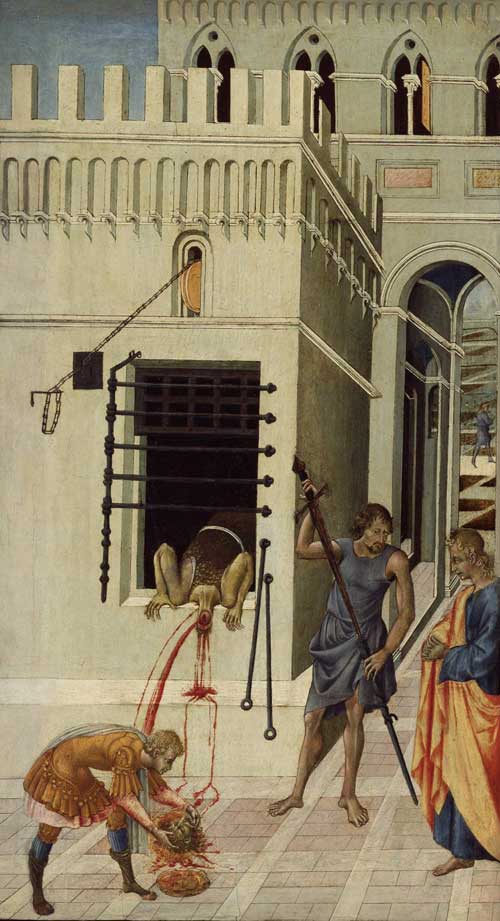Great Works: The Beheading of St John the Baptist (1450s), Giovanni di Paolo
Art Institute of Chicago

Films today come with censor's advice, declaring what they contain in terms of language, sex, nudity and violence, often registering fine gradations. Contains moderate language and one scene of moderate sexualised nudity. Contains strong language, sex references and brief bloody violence. Contains frequent moderate action violence. Contains strong language, sex references and nudity. Contains very strong language and strong bloody violence. Contains very strong bloody violence, medical gore and sustained terrorisation etc.
There is no censorship of paintings. If there were, what would it say? The old masters, when they occasionally added words, used the most decorous language, taken from the scriptures or the classics. When it comes to sex and nudity, there is plenty in post-Renaissance images, though how sexualised the nudity, how strong the sex is, can be uncertain. As for violence, in art from all ages it is frequently extreme. Paintings contain very strong bloody violence. In spite of our high expectations of high art, we can hardly fail to notice this – and even have qualms.
In fact, our objections to violence in art are resourceful. We worry in opposite ways. Sometimes it seems that the treatment of violence is too sensational, gruesome, relishing. Sometimes it seems too beautifying, formal, composed (this is a subtlety the film censors overlook. They never say: contains brief aestheticised violence.) Both attitudes have something heartless about them. One approach plays the violence up and the other plays it down. Both offer a wrong, though different, kind of enjoyment. And given that violence shouldn't be wholly excluded from art, but shouldn't be made too enjoyable either, it seems hard to get its treatment right.
There are some pictures that at least achieve a mixture: gore and aesthetics crossed. Giovanni di Paolo's The Beheading of St John the Baptist is one. This small episodic panel comes from a sequence about the harbinger-saint, who went into the wilderness and announced the coming of Christ. Later, he was imprisoned by King Herod for criticism. Then Salome danced for the king, with strong sex references, and demanded his separated head as her prize.
It's a scene of shocking realism, psychological and anatomical. The king, a meekly monstrous figure, creeps in to supervise the executioner, who is just concluding his calm work. Meanwhile, before us there is the revolting accuracy of the beheading. St John's torso appears through the prison bars, with its bunched arms, its stretched and severed neck, suggesting a cook's chicken, plucked, trussed, decapitated.
His cut neck sends out a double issue of blood. One stream spills downward from the wound in dribbles. The other is an arcing jet of arterial blood spurting outwards. These details were presumably public knowledge. Both the artist and his audience had seen this kind of thing happening in the piazza, in penal actions.
Around the human mess, the whole scene is beautifully clean and straight. Red spatters on white. The sticky gouts of blood play against the smooth planes and sharp corners of the prison architecture. The arches and castellations, the tiled paving and the oblique chequerboard countryside glimpsed through the gateway: all this neatness stresses, by contrast, the bloodletting. A soldier picks up the Saint's dripping head from the ground. Its halo lies beneath it like a golden plate.
But there is also pattern in the violence. The swinging bars of the jail's grille echo the executioner's sword. The trajectory of St John's arcing blood is paralleled by the slant of the diagonal chain coming out from the pulley in the wall above it at 45 degrees. The end of this curve of blood is picked up by the soldier's cloak as it hangs at a vertical from his neck.
And the other stream of the Saint's blood, pouring down, descends in a straight drool onto the stone ledge below it, pools there, forks into two, trickles in double parallel lines onto the pavement, then forks again. The carnage falls into these elegant arrangements, but they also make it crueller: human blood is compared to hard metalwork.
There is bloodshed and geometry, and Di Paolo makes them both like and unlike. The effect is both to aggravate and to compose the horror, in ways that can't be disentangled. Quite proper, perhaps, given what the subject is. This isn't just any killing. It's a martyrdom, so the meaning of its violence is inherently ambivalent. On the part of the perpetrators, it's outrageous. On the part of the sufferer, it's to be honoured. This makes art's treatment easier. Almost any mixture of feelings will do.
In The Beheading of St John the Baptist the balance probably favours degradation. The spouting chicken-victim isn't much redeemed by the formal patterns. But the general case of martyrdom suggests another refinement of the censor's classifications. Contains very strong bloody glorifying violence.
About the artist
Giovanni di Paolo (roughly 1399-82) was a Sienese painter about whose long life little is known. His fame resurfaced in the 20th century. A good deal of his work is known. There is his 'St John the Baptist Goes into the Wilderness' to be seen in the National Gallery. He painted radiant heavens and crisscross landscapes. He illustrated Dante. He practised the wiry, old-fashioned manner of the International Gothic, with a fantastic imagination. He is compared with De Chirico. One modern art historian says,"Few experiences in Italian painting are more exciting than to follow Giovanni de Paolo as he plunges, like Alice, through the looking-glass."
Subscribe to Independent Premium to bookmark this article
Want to bookmark your favourite articles and stories to read or reference later? Start your Independent Premium subscription today.

Join our commenting forum
Join thought-provoking conversations, follow other Independent readers and see their replies